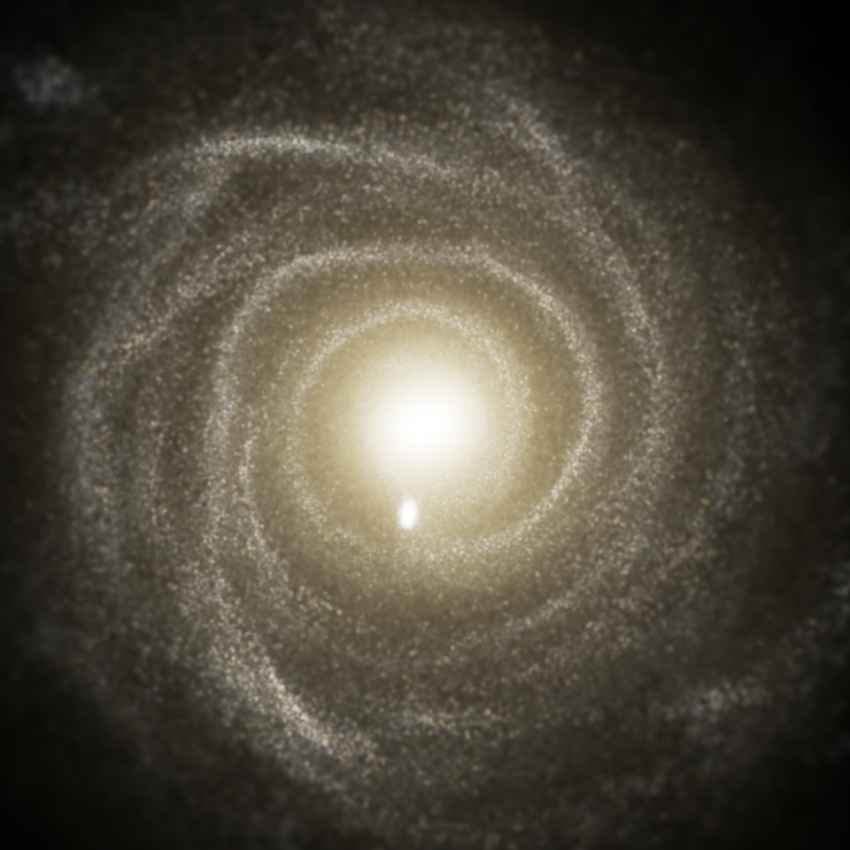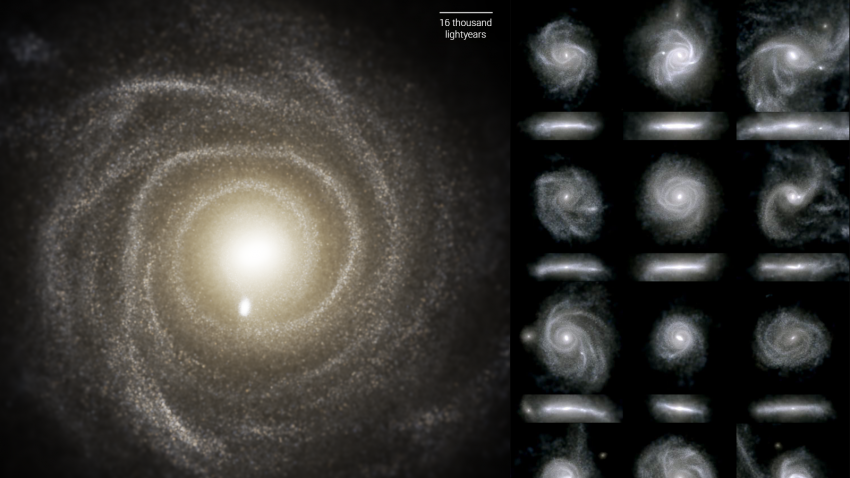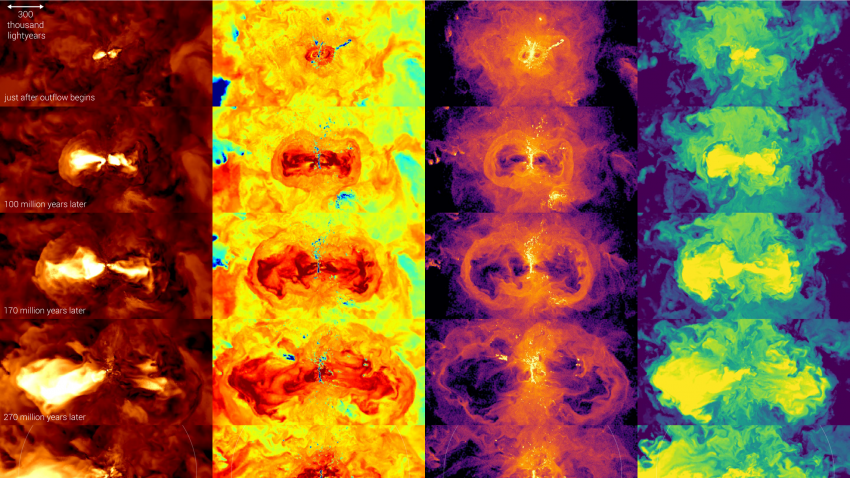Scientists from Germany and the United States have unveiled the results of a newly-completed, state of the art simulation of the evolution of galaxies. TNG50 is the most detailed large-scale cosmological simulation yet. It allows researchers to study in detail how galaxies form, and how they have evolved since shortly after the Big Bang. For the first time, it reveals that the geometry of the cosmic gas flows around galaxies determines galaxies’ structures, and vice versa. The researchers publish their results in two papers in the journal Monthly Notices of the Royal Astronomical Society.
Astronomers running cosmological simulations face a fundamental trade-off: with finite computing power, typical simulations so far have been either very detailed or have spanned a large volume of virtual space, but have so far not been able to do both. Detailed simulations with limited volumes can model no more than a few galaxies, making statistical deductions difficult. Large-volume simulations, in turn, typically lack the details necessary to reproduce many of the small-scale properties we observe in our own Universe, reducing their predictive power.
The TNG50 simulation, which has just been published, manages to avoid this trade-off. For the first time, it combines the idea of a large-scale cosmological simulation – a Universe in a box – with the computational resolution of “zoom” simulations, at a level of detail that had previously only been possible for studies of individual galaxies.
In a simulated cube of space that is more than 230 million light-years across, TNG50 can discern physical phenomena that occur on scales one million times smaller, tracing the simultaneous evolution of thousands of galaxies over 13.8 billion years of cosmic history. It does so with more than 20 billion particles representing dark (invisible) matter, stars, cosmic gas, magnetic fields, and supermassive black holes. The calculation itself required 16,000 cores on the Hazel Hen supercomputer in Stuttgart, working together, 24/7, for more than a year – the equivalent of fifteen thousand years on a single processor, making it one of the most demanding astrophysical computations to date.
The first scientific results from TNG50 are published by a team led by Dr Annalisa Pillepich (Max Planck Institute for Astronomy, Heidelberg) and Dr Dylan Nelson (Max Planck Institute for Astrophysics, Garching) and reveal unforeseen physical phenomena. According to Nelson: “Numerical experiments of this kind are particularly successful when you get out more than you put in. In our simulation, we see phenomena that had not been programmed explicitly into the simulation code. These phenomena emerge in a natural fashion, from the complex interplay of the basic physical ingredients of our model universe.”
TNG50 features two prominent examples for this kind of emergent behaviour. The first concerns the formation of “disc” galaxies like our own Milky Way. Using the simulation as a time machine to rewind the evolution of cosmic structure, researchers have seen how the well-ordered, rapidly rotating disc galaxies (which are common in our nearby Universe) emerge from chaotic, disorganised, and highly turbulent clouds of gas at earlier epochs.
As the gas settles down, newborn stars are typically found on more and more circular orbits, eventually forming large spiral galaxies – galactic carousels. Annalisa Pillepich explains: “In practice, TNG50 shows that our own Milky Way galaxy with its thin disc is at the height of galaxy fashion: over the past 10 billion years, at least those galaxies that are still forming new stars have become more and more disc-like, and their chaotic internal motions have decreased considerably. The Universe was much messier when it was just a few billion years old!”
As these galaxies flatten out, researchers found another emergent phenomenon, involving the high-speed outflows and winds of gas flowing out of galaxies. This launched as a result of the explosions of massive stars (supernovae) and activity from supermassive black holes found at the heart of galaxies. Galactic gaseous outflows are initially also chaotic and flow away in all directions, but over time, they begin to become more focused along a path of least resistance.
In the late universe, flows out of galaxies take the form of two cones, emerging in opposite directions – like two ice cream cones placed tip to tip, with the galaxy swirling at the centre. These flows of material slow down as they attempt to leave the gravitational well of the galaxy’s halo of invisible – or dark – matter, and can eventually stall and fall back, forming a galactic fountain of recycled gas. This process redistributes gas from the centre of a galaxy to its outskirts, further accelerating the transformation of the galaxy itself into a thin disc: galactic structure shapes galactic fountains, and vice versa.
The team of scientists creating TNG50 (based at Max-Planck-Institutes in Garching and Heidelberg, Harvard University, MIT, and the Center for Computational Astrophysics (CCA)) will eventually release all simulation data to the astronomy community at large, as well as to the public. This will allow astronomers all over the world to make their own discoveries in the TNG50 universe – and possibly find additional examples of emergent cosmic phenomena, of order emerging from chaos.
Media contacts
Dr Hannelore Hämmerle
MPA
Tel: +49 89 30 000 3980
hanneh@mpe.mpg.de
Dr Markus Pössel
MPIA
Tel: +49 6221 528 261
pr@mpia.de
Dr Robert Massey
Royal Astronomical Society
Tel: +44 (0)20 7292 3979
Mob: +44 (0)7802 877 699
press@ras.ac.uk
Dr Morgan Hollis
Royal Astronomical Society
Mob: +44 (0)7802 877 700
press@ras.ac.uk
Science contacts
Dr Dylan Nelson
MPA
Phone: +49 89 30 000 2251
dnelson@mpa-garching.mpg.de
Dr Annalisa Pillepich
MPIA
Phone: +49 6221 528 395
pillepich@mpia-hd.mpg.de
Images, movies and captions
The formation of a single massive galaxy through time, from early cosmic epochs until the present day, in the TNG50 cosmic simulation. The main panel shows the density of the cosmic gas (high in white, low in black). Insets show large-scale dark matter and then gas (lower left), and small-scale stellar and gaseous distributions (lower right). This TNG50 galaxy will be similar in mass and shape to Andromeda (M31) by the time the movie reaches the current epoch. Its progenitor experiences rapid star formation in a turbulent gas reservoir which settles into an ordered disc after a couple of billion years of cosmic evolution. A rather quiet late time assembly history without major mergers allows the galaxy to relax into an equilibrium balance of gas outflows from supernova explosions and gas accretion from its surroundings.
Credit: D. Nelson (MPA) and the IllustrisTNG team
Further information
The new work appears in two papers, both free to view:
“First Results from the TNG50 Simulation: The evolution of stellar and gaseous disks across cosmic time”, A. Pillepich et al., Monthly Notices of the Royal Astronomical Society (2019), in press (10.1093/mnras/stz2338).
A copy of the paper is available from: https://doi.org/10.1093/mnras/stz2338
“First Results from the TNG50 Simulation: Galactic outflows driven by supernovae and black hole feedback”, D. Nelson et al., Monthly Notices of the Royal Astronomical Society (2019), in press (DOI: 10.1093/mnras/stz2306).
A copy of the paper is available from: https://doi.org/10.1093/mnras/stz2306
Click here to explore more TNG media and a gallery of images.
Notes for editors
The Royal Astronomical Society (RAS), founded in 1820, encourages and promotes the study of astronomy, solar-system science, geophysics and closely related branches of science. The RAS organises scientific meetings, publishes international research and review journals, recognises outstanding achievements by the award of medals and prizes, maintains an extensive library, supports education through grants and outreach activities and represents UK astronomy nationally and internationally. Its more than 4,400 members (Fellows), a third based overseas, include scientific researchers in universities, observatories and laboratories as well as historians of astronomy and others.
The RAS accepts papers for its journals based on the principle of peer review, in which fellow experts on the editorial boards accept the paper as worth considering. The Society issues press releases based on a similar principle, but the organisations and scientists concerned have overall responsibility for their content.
Follow the RAS on Twitter, Facebook, Instagram and YouTube




